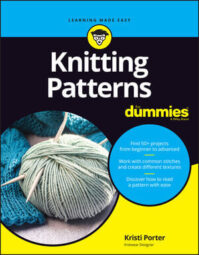Keep charts handy of your body measurements and yardage estimates of commonly knitted items so that you're ready to start a knitting project at anytime.
Terms and abbreviations used in knitting patterns
Knitting has its own writing method, so when you look at knitting patterns you may see a variety of unfamiliar terms and abbreviations. Once you know the following list of common knitting abbreviations, you’re well on your way to easily translating knitting patterns:
| BO | bind off (cast off) |
| CC | contrasting color |
| cm | centimeters |
| cn | cable needle |
| CO | cast on |
| dec | decrease |
| dpn(s) | double-pointed needle(s) |
| g | grams |
| inc | increase |
| k | knit |
| k2tog | knit 2 together (a decrease) |
| kfb | -knit into the front and back of the stitch (an increase) |
| knitwise | as if to knit |
| LT | left twist |
| m | meters |
| m1 | make 1 (an increase) |
| MC | main color |
| mm | millimeters |
| oz | ounce |
| p | purl |
| p2tog | purl 2 together (a decrease) |
| pfb | -purl into the front and back of the stitch (an increase) |
| pm | place marker |
| psso | pass the slipped stitch over |
| purlwise | as if to purl |
| rnd(s) | round(s) |
| RS | right (public) side |
| RT | right twist |
| skp | -slip 1, knit 1, pass the slipped stitch over (a decrease) |
| s2kp | -slip 2, knit 1, pass the 2 slipped stitches over (a double decrease) |
| sk2p | -slip 1, k2tog, pass the slipped stitch over (a double decrease) |
| sl | slip |
| sl st | slip stitch |
| ssk | slip, slip, knit (a decrease) |
| st(s) | stitch(es) |
| tbl | through the back loop(s) |
| tog | together |
| work even | work without increasing or decreasing |
| WS | wrong (non-public) side |
| wyib | with yarn in back |
| wyif | with yarn in front |
| yd(s) | yard(s) |
| yo | yarn over (an increase) |
How to convert metric measurements on knitting patterns
Reading knitting patterns can be slow work if you’re not used to converting from metric measurements to yards, inches, and ounces. Speed up your knitting projects when you’re figuring out materials by using these metric conversions. hese are approximations, but they’re easy to do in your head and close enough for your knitting needs!
-
Yards and meters: A yard is 36 inches. A meter is 39 inches. Multiply yards by 90 percent (0.9) to get meters (100 yards = 90 meters). Multiply meters by 110 percent (1.1) to get yards (100 meters = 110 yards).
-
Inches and centimeters: Multiply the number of inches by 2.5 to get centimeters (for example, 4 inches ∞ 2.5 = 10 cm). Divide the number of centimeters by 2.5 to get inches (for example, 10 cm ÷ 2.5 = 4 inches).
-
Ounces and grams: 50 grams = 1.75 ounces. 100 grams = 3.5 ounces.
Body measurements chart for knitting projects
Before starting a new knitting pattern, record your body measurements —and those of friends and family — for an accurate fit. Don’t let your knitted projects go unworn because the measurements were off. Here’s a handy chart to record measurements for knitting patterns.
| Body Part | My Numbers | ___________ Numbers | ___________ Numbers |
|---|---|---|---|
| Chest | |||
| Waist | |||
| Hips | |||
| Cross back | |||
| Sleeve length | |||
| Back to waist | |||
| Total length | |||
| Foot length | |||
| Head circumference |
Knitting: estimating how much yarn you need
If you’re not working directly from a knitting pattern, then use this chart to estimate your yarn needs. This table shows you some typical knitting patterns and yardage approximations for a variety of sizes. Smaller sizes obviously need the yardage at the low end of the range, and larger sizes need yardage at the high end of the range. Heavily textured knitting projects (think ribs or cables) also need more yarn.
| Yarn Weight Category | Types of Yarn in Category | Gauge (Stitches per Inch) | Yards Needed for a Hat | Yards Needed for a Scarf | Yards Needed for an Adult Sweater | |
|---|---|---|---|---|---|---|
| 1 | Superfine | sock, fingering, baby | 7 to 8 | 300 to 375 | 350 | 1,500 to 3,200 |
| 2 | Fine | sport, baby | 6 to 7 | 250 to 350 | 300 | 1,200 to 2,500 |
| 3 | Light | DK, light worsted | 5 to 6 | 200 to 300 | 250 | 1,000 to 2,000 |
| 4 | Medium | worsted, aran | 4 to 5 | 150 to 250 | 200 | 800 to 1,500 |
| 5 | Bulky | chunky, craft, rug | 3 to 4 | 125 to 200 | 150 | 600 to 1,200 |
| 6 | Super bulky | bulky, roving | 1-1/2 to 3 | 75 to 125 | 125 | 400 to 800 |

